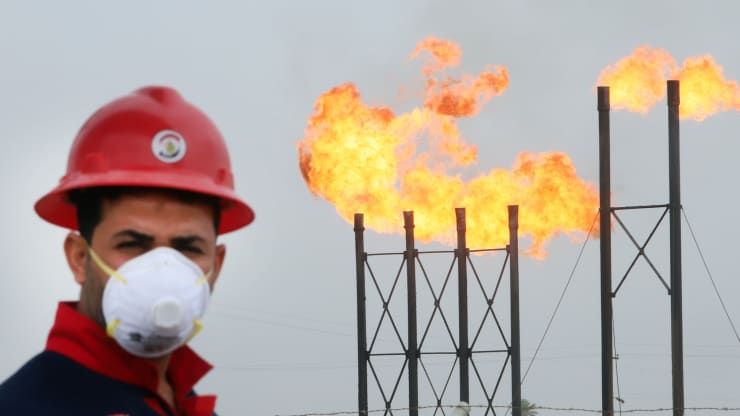The 23 member states of OPEC+, comprised of OPEC and ten of its oil-producing allies, for the most part delivered on record production cuts agreed to by the alliance through the month of May, a new report shows.

Source: CNBC
“OPEC’s 13 members dropped their output to 24.32 million b/d, for a compliance rate of 82% with their prescribed cuts,” S&P Global Platts found in a survey released Wednesday.
The ten non-OPEC members, which include Russia, pumped a combined 13.89 million barrels per day comprising 91% of their cuts, bringing OPEC+’s collective compliance to 85%, Platts reported.
Following the coronavirus pandemic-induced plunge in oil prices, OPEC+ embarked on the largest coordinated oil production cut regime in history in May. They agreed to cut 9.7 million bpd in an effort to support the market, amounting to about 10% of global oil supply.
In total, Platts found that the coalition managed to reduce its output by a combined 8.28 million bpd for the month.
The OPEC+ alliance agreed over the weekend to extend the cuts through July, with Saudi Energy Minister Abdulaziz bin Salman asserting that this time there would be “no room whatsoever for lack of conformity.”
But the pacts have traditionally been difficult to enforce, with some members — particularly Iraq and Nigeria — falling behind on their cutting commitments, and OPEC kingpin Saudi Arabia shouldering the overwhelming majority of cuts, often slashing their output by more than their required quota.
Iraq, OPEC’s second-largest producer, was the group’s biggest offender, pumping 4.19 million bpd in May — some 600,000 bpd over its agreed limit. Nigeria, Angola and Gabon, as well as non-OPEC states Kazakhstan and Azerbaijan, were among the other laggards.
The group’s most recent agreement included a promise by non-compliant countries to compensate for any barrels they didn’t cut in May or June by making deeper reductions between July and September.
Iraq’s oil ministry said this week it is “fully committed” to cutting its production from June onward in accordance with the OPEC+ deal.
Will Iraq comply with the cuts?
But how this will be enforced remains unclear, and many doubt the capability of Iraq in particular to get its production down to where the Saudis want it. Deep cuts to production are something particularly painful for the war-weary country, where 90% of state revenues come from oil exports.
“The actual mechanism for punishing errant producers is unclear,” RBC Capital Markets analysts wrote this week in a client note. “The OPEC leaders did not specifically respond to questions about the Iraqi finance minister’s request for a quota reconsideration based on ‘economic conditions and living standards’. We remain skeptical about Iraq’s ability to meet their enhanced output commitments.”
For Iraq, as well as Nigeria and Kazakhstan, “it may prove difficult for them to match their commitments 100%, because of the contractual agreements these countries have with upstream companies,” David Fyfe, chief economist at energy analytics firm Argus, told CNBC.
Issues with enforcement may even be political, given the balancing act of Iraq’s relationships with Tehran and Riyadh, longtime adversaries.
“Politically, Saudi Arabia probably does not want to put a spoke in the Iraqi government’s wheel, as it could further embolden Iran’s influence in Iraq,” commodities data firm Kpler wrote in a note Wednesday. “The kingdom’s lever within OPEC+ may be much (more) limited than thought.”
Still, some are confident in a more compliant Iraq.
“We expect Iraq to improve to 80% to 90% in coming months,” said Abhi Rajendran, a head of research at Energy Intelligence. “If prices are still weak there will be more scrutiny for them to be compliant. But if prices are much higher, like $50+, there will be less pressure on them.”
Essentially, if prices go higher — which is what most forecasters are predicting, many expecting $50 a barrel by the first quarter of 2021 — there will be less stress to get every country in line. Brent crude was trading a $39.42 a barrel at 9 a.m. ET on Thursday.
This is OPEC’s long-time conundrum, Argus’ Fyfe says: “They can have high prices or high market share, but seldom can they achieve both at the same time.”

